Hydraulic oil cooler loses a lot of its characteristic at high temperatures. Heat not only reduces the viscosity and the durability of the oil but it also increases the wear and tear of the hydraulic components of the system. It is therefore important to cool the oil.
In the industry various types of cooling media are used to transfer heat from cooling oils & lubricants e.g. water, air, refrigerants, hydrogen. Of these we discuss primarily the two cooling media that are most commonly used & readily available, with a relatively low cost viz. Air and water.
Air Cooled Oil Cooler / Fluid Coolers with Fan: In air cooled oil coolers the hot oil or fluid is passed in close proximity to a blast of ambient air. The heat exchange takes place across a barrier between the hot oil and cool ambient air (refer Fig. A).

There are primarily three types of air cooled oil coolers or air cooled heat exchangers, based on construction design & the manufacturing process used. Each type has a similar working mechanism & performs similar function.
- Tube Fin Type – (Fig. B)
- Plate Fin Type – (Fig. C)
- Stacked Layer or D Cup Type – (Fig. D)
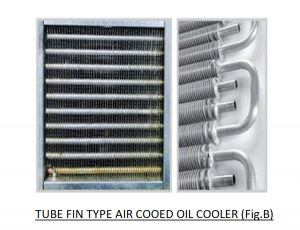
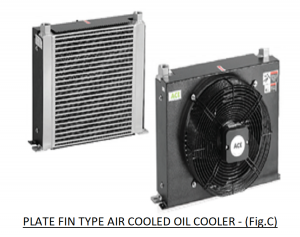
 Water Cooled Oil Coolers: The hot oil is passed in close proximity to water cooled oil cooler and the air cooled heat exchanger takes place across a barrier between the hot oil and cool cooling water (refer Fig. E).
Water Cooled Oil Coolers: The hot oil is passed in close proximity to water cooled oil cooler and the air cooled heat exchanger takes place across a barrier between the hot oil and cool cooling water (refer Fig. E).
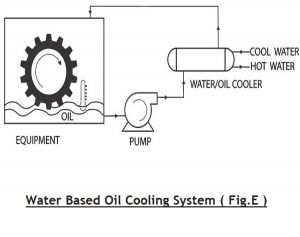
These are mainly of three types.
- Shell & Tube Type – Fig. F
- Gasket Plate Type – Fig. G
- Brazed Plate Type – Fig. H
The hot & cool fluids enter the heat exchanger through respective inlet ports. After the heat exchange takes place across a barrier separating the two fluids, the fluids exit the heat exchanger through the outlet ports. The shell & tube heat exchangers comprises of a tube bundle encased in an outer housing or shell. The cool fluid usually travels through the tubes & the hot fluid moves in the shell. The heat exchange taking place across the tube surface as shown in ( Fig. F )

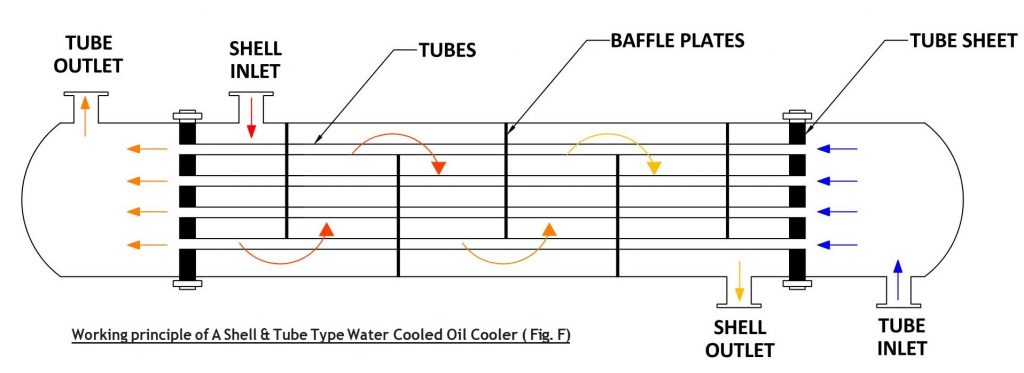
The gasket plate & the brazed plate type heat exchangers consist of parallel plates. The hot and cool fluids flow in between alternating plates, as shown in (Fig. I)
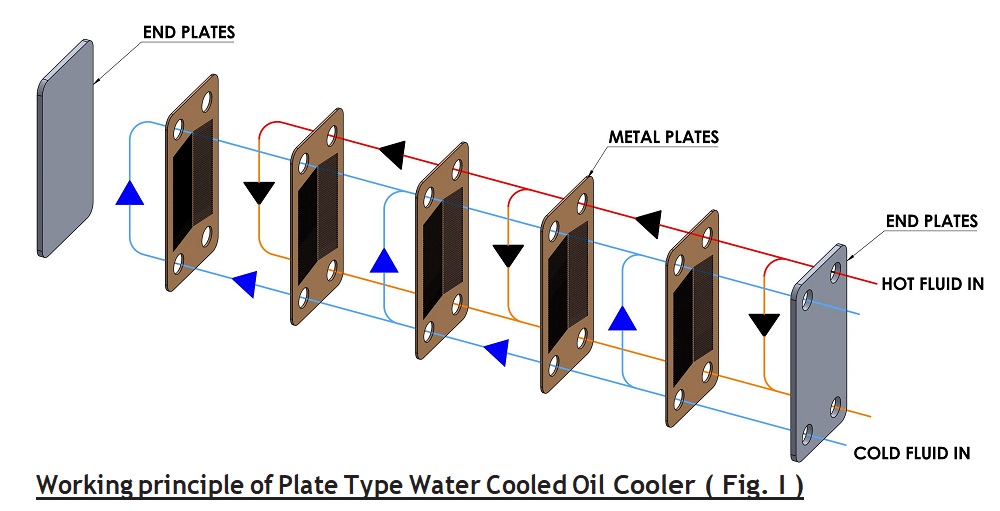
As the name suggest, in the gasket plate type alternating layers of gaskets & plates are bolted together (Fig. G).
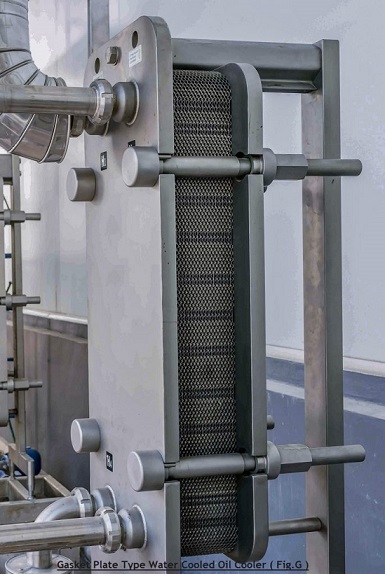 The Brazed plate type is similar in construction except that the plates are brazed together in a vacuum furnace. The primary advantages of brazed plate type over gasket plate ones is that the chance of intermixing of the fluids due to a damaged gasket is minimized and they can handle higher working pressures.
The Brazed plate type is similar in construction except that the plates are brazed together in a vacuum furnace. The primary advantages of brazed plate type over gasket plate ones is that the chance of intermixing of the fluids due to a damaged gasket is minimized and they can handle higher working pressures.
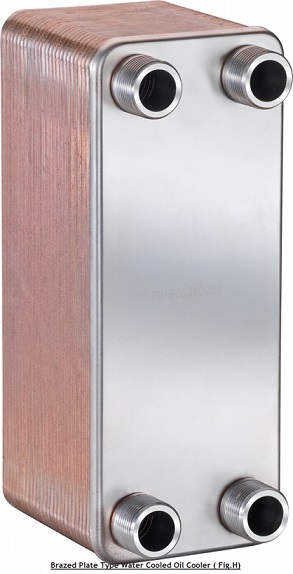
Let’s take a closer look at a water based oil cooling system (Fig. A). The hot oil from the equipment is pumped through the shell of a water cooled heat exchanger & the cooling water is passed through the tubes. There is exchange of heat between the hot oil & the cooling water. The hydraulic oil air cooler is returned back to the oil sump or reservoir. The water after it has performed its function of removing the heat from the oil, is itself now warm and has lost the ability to further extract heat efficiently. What do we do with this water? In the olden days it was simply flushed away and more fresh water was used for cooling. With growing environmental concerns coupled with the scarcity and cost of fresh water, it needs to be recirculated. In order for it to be effectively re-used as a cooling media, the water needs to lose the heat that it has picked up and be cool enough to be able to remove heat efficiently from the oil. For this the warm water is then pumped to a cooling tower where an air draft is used to cool it. There are two processes involved here – the cooling of oil using water, which in turn gets heated & the cooling of hot water with ambient air. As we know that no process is 100% efficient. Assuming we have two well-designed processes, each having an overall efficiency of say 80%, we have 20% loss of efficiency in each process. From (Fig. A) of a water cooled oil cooling system it is evident that we have a total loss of efficiency of 20% + 20%.
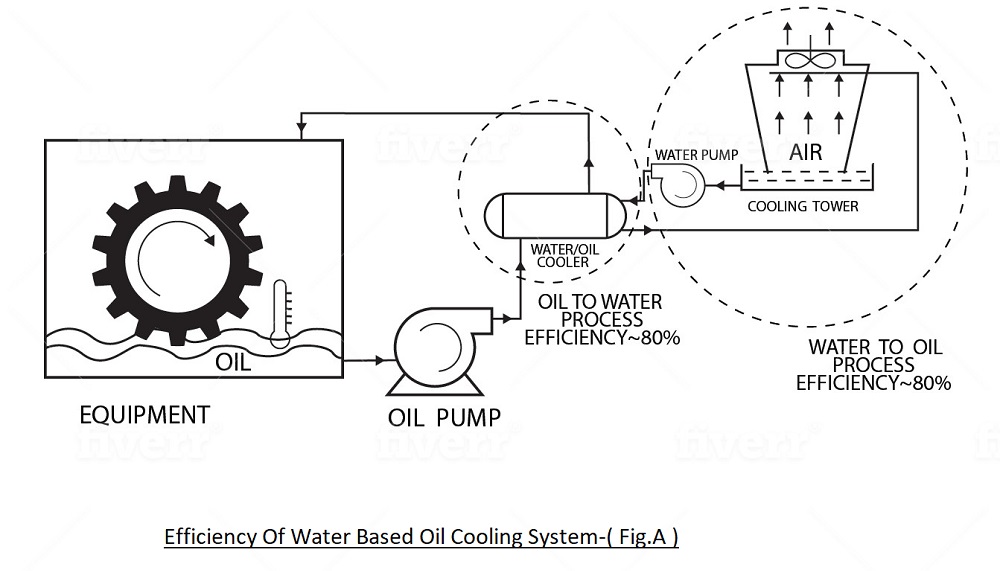
In comparison if we look at an air cooled oil cooling system, we have only one process. Again assuming we have a well-designed process with an overall efficiency of 80%, there is a direct benefit of 20% in improved efficiency (refer Fig. b) while using an air cooled heat exchangers in comparison to a water based one.
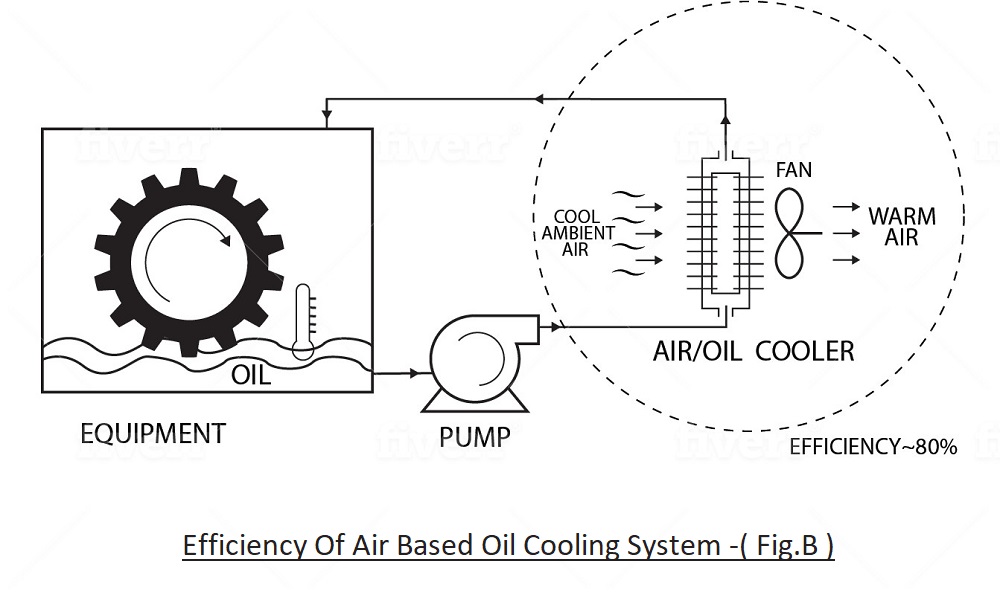
There are other important nuances that need to be considered. For instance the cost of energy required to pump cooling water for the entire usable life of the equipment. There is also the cost of plumbing in the initial setup, coupled with the hidden cost of maintenance of the water pump & the plumbing. It is also noteworthy that the water needs to be treated to remove salts and minerals, in order to achieve consistent heat exchange. Untreated cooling water is more often than not, laden with salts and minerals. These too add their bit to a maintenance engineer’s woes. The salts & minerals present in the water deposit on the barrier between the two fluids, commonly known as scaling. (Fig. c) shows scaling in shell – tube & gasket plate type heat exchangers. Water scale is a bad conductor of heat. Therefore the ability of the oil cooler to transfer heat reduces considerably over time, due to scaling.
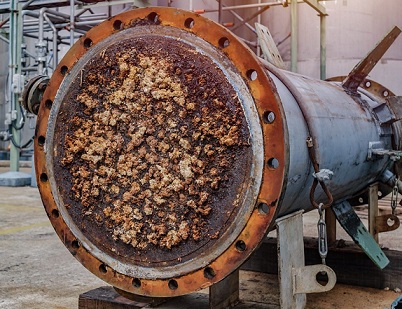
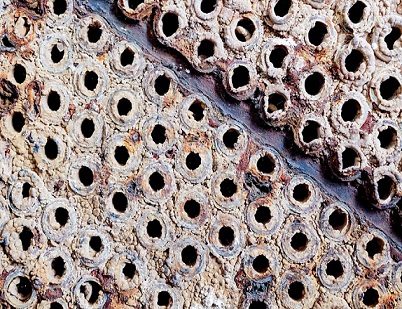
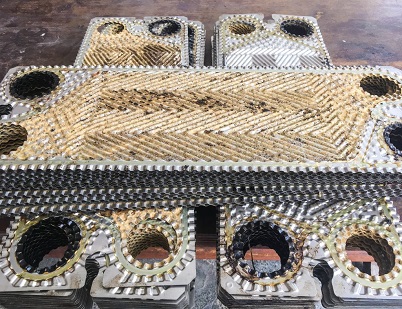
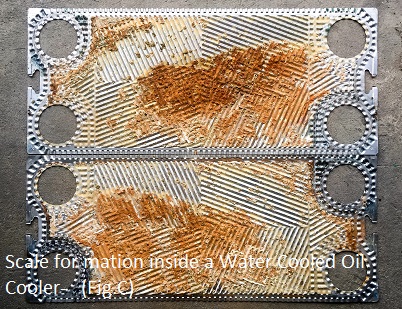 Water based oil coolers therefore need to be descaled. (Fig. d) depicts the typical heat dissipation performance cycle of a water based oil cooler. As the water flows through the oil cooler, salts start depositing on the surface of the tube or plate barrier between the two fluids, through which the heat is being transferred. These salt or chemical deposits called scale (usually white or off white in color) build up over time. As a result heat exchange reduces considerably. Water cooled heat exchangers therefore need to be serviced or descaled from time to time. From the graph in (Fig. d), it is evident that the performance reduces with respect to usage time. The extent of loss in efficiency is dependent on the quality of water available at the site of usage. The amount and type of dissolved salts & minerals in the water determines the frequency of descaling (or servicing in case of gasket plate heat exchangers).
Water based oil coolers therefore need to be descaled. (Fig. d) depicts the typical heat dissipation performance cycle of a water based oil cooler. As the water flows through the oil cooler, salts start depositing on the surface of the tube or plate barrier between the two fluids, through which the heat is being transferred. These salt or chemical deposits called scale (usually white or off white in color) build up over time. As a result heat exchange reduces considerably. Water cooled heat exchangers therefore need to be serviced or descaled from time to time. From the graph in (Fig. d), it is evident that the performance reduces with respect to usage time. The extent of loss in efficiency is dependent on the quality of water available at the site of usage. The amount and type of dissolved salts & minerals in the water determines the frequency of descaling (or servicing in case of gasket plate heat exchangers).

These cost heavily, not only in terms of maintenance cost, cost of gaskets / descaling chemicals time, money & production loss due to repeated maintenance shutdowns.
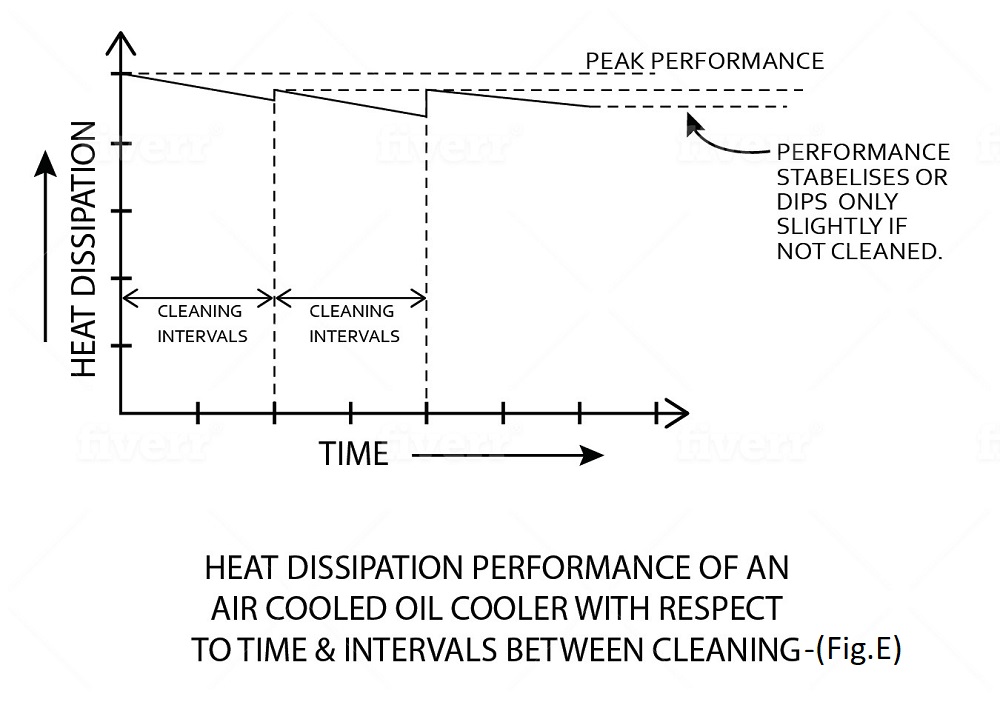
A compressed air blast oil cooler done regularly is enough to remove the dust build up. This cleaning can be carried out while the system is still operative & does not require a shut down. Besides the above an obvious advantage of an air cooled oil cooler is that as it does not require water, which means that equipment requiring cooling need not be near a cooling water connection or source. The machine can therefore be stand alone. Just plug in the electrical power and we are good to go. On the contrary every time a machine with a water based oil cooling needs to be shifted or relocated, the water supply plumbing needs to be redone. Further, the problems associated with treatment and disposal of water have become more costly with government regulations and environmental concerns. Air-cooled or air blast or fan cooled oil coolers as they are commonly called provide means of transferring the heat from the fluid directly into ambient air, without environmental concerns and at a nominal running cost. On the other hand let’s look at an air based oil cooling system. Here too there is a drop in efficiency with time, as dust and pollutants from the atmosphere deposit on the fin surface (refer Fig. E). The fins too need to be cleaned. But the cleaning process is simple and effective.
A compressed air blast done regularly is enough to remove the dust build up. This cleaning can be carried out while the system is still operative & does not require a shut down. Besides the above an obvious advantage of an air cooled oil cooler is that as it does not require water, which means that equipment requiring cooling need not be near a cooling water connection or source. The machine can therefore be stand alone. Just plug in the electrical power and we are good to go. On the contrary every time a machine with a water based oil cooling needs to be shifted or relocated, the water supply plumbing needs to be redone. Further, the problems associated with treatment and disposal of water have become more costly with government regulations and environmental concerns. Air-cooled oil cooler or air blast oil cooler or fan cooled oil coolers as they are commonly called provide means of transferring the heat from the fluid directly into ambient air, without environmental concerns and at a nominal running cost.
Having extensive experience in design, manufacturing, installation and maintenance of hydraulic lubrication and cooling systems we not only understand the importance of Oil Coolers but also finer points in a coolers design. Easy to install and maintain Ace air cooled heat exchangers manufacturers are designed to obtain maximum cooling efficiency while keeping the cost low.
Kindly provide some or all of the following information:
a. Motor HP
b. Pump (LPM)
c. Working Pressure (bar)
d. Tank Capacity
e. Max. Ambient temperature at site
f. Required Oil Temperature
g. Pump used is Variable or Fixed
h. Application/ Industry
For most medium to large continuous duty machines fitment of adequately sized air cooled oil coolers becomes mandatory for achieving temperature optimized systems that keep oil temperatures within an acceptable range. Doing so is a basic prerequisite for cost-efficient operation, as they provide a number of performance, economic, and environmental benefits. These include:
- Maintaining the correct temperature keeps oil at its recommended viscosity and ensures that mechanical components are properly lubricated and fluid power devices run at peak performance & efficiency, thereby reducing energy bills. Letting oil temperature rise beyond recommended limits can reduce the life of the equipment due to poor lubrication higher internal & external leakages, and a higher risk of component damage.
- Operation within recommended tem- perature range increases equipment’s availability and efficiency thereby improving productivity.
- Keeping temperatures down also helps ensures that the oil last longer. Excess heat can degrade oils, form harmful varnish / sludge on component surfaces, and accelerate the deterioration of rubber and elastomeric seals, leading to leakages & loss of expensive oils. The sludge formed also results in sticking of internal moving parts of valves & other components.
- With less machine downtime it reduces service and repair costs.
- Accurate sizing of oil coolers is an extremely important task of a design engineer, considering the resulting benefits air cooled heat exchangers offer. Under sizing results in higher than recommended oil temperatures yet over sizing is an increased expense due to a larger-than-necessary purchase. However when in doubt a larger sized oil cooler is definitely a better option in comparison to an under sized one.
Air Cooled Oil Coolers ?
If your queries are still not
answered, please get in touch with
us.

